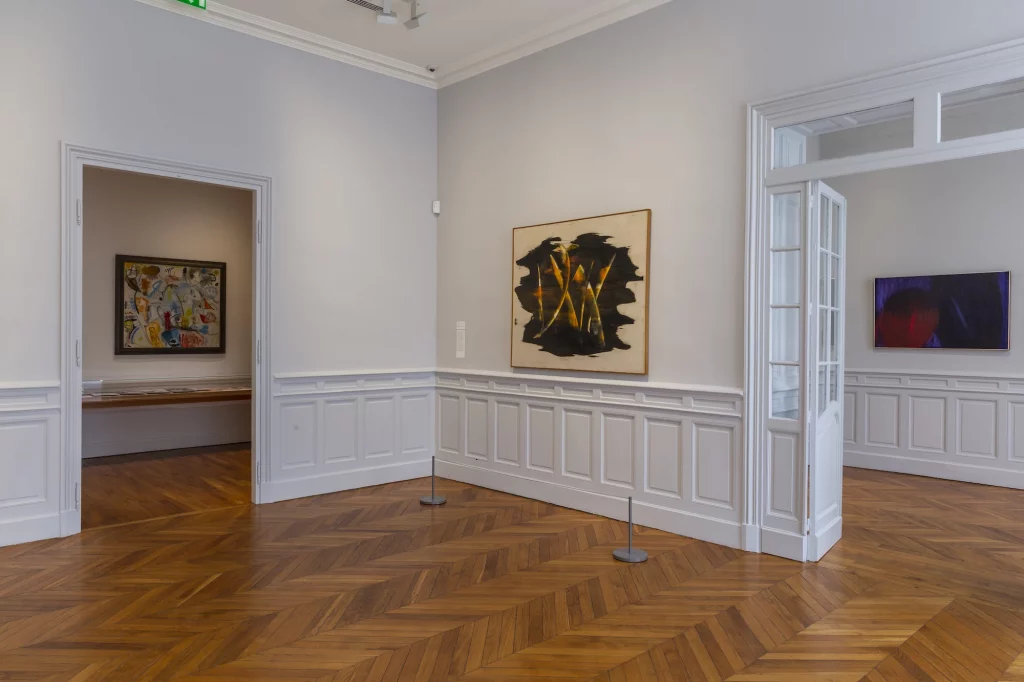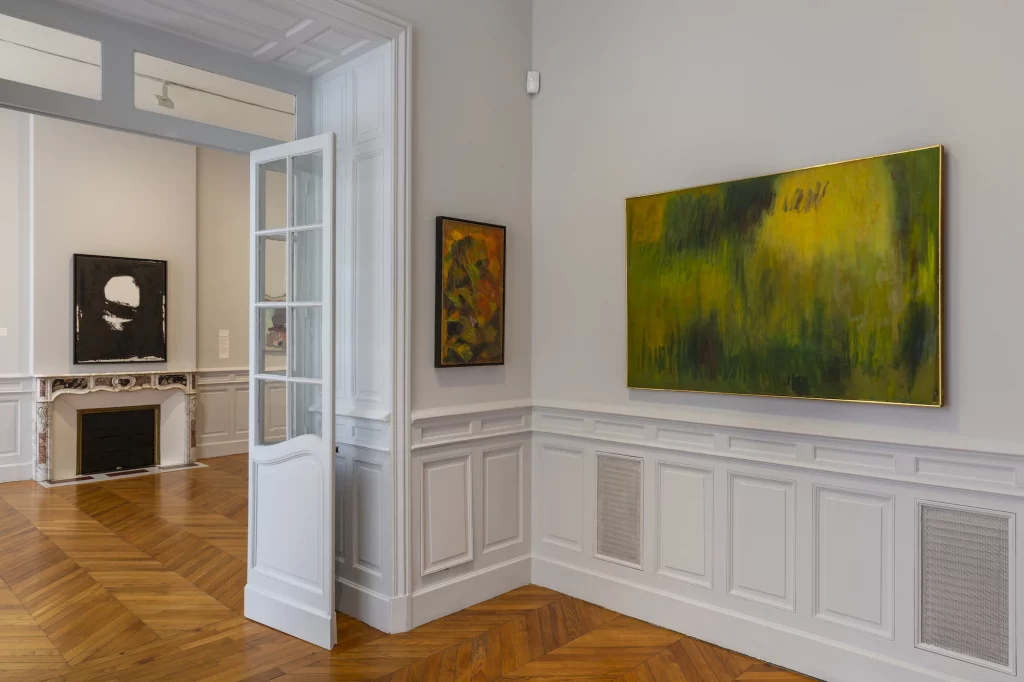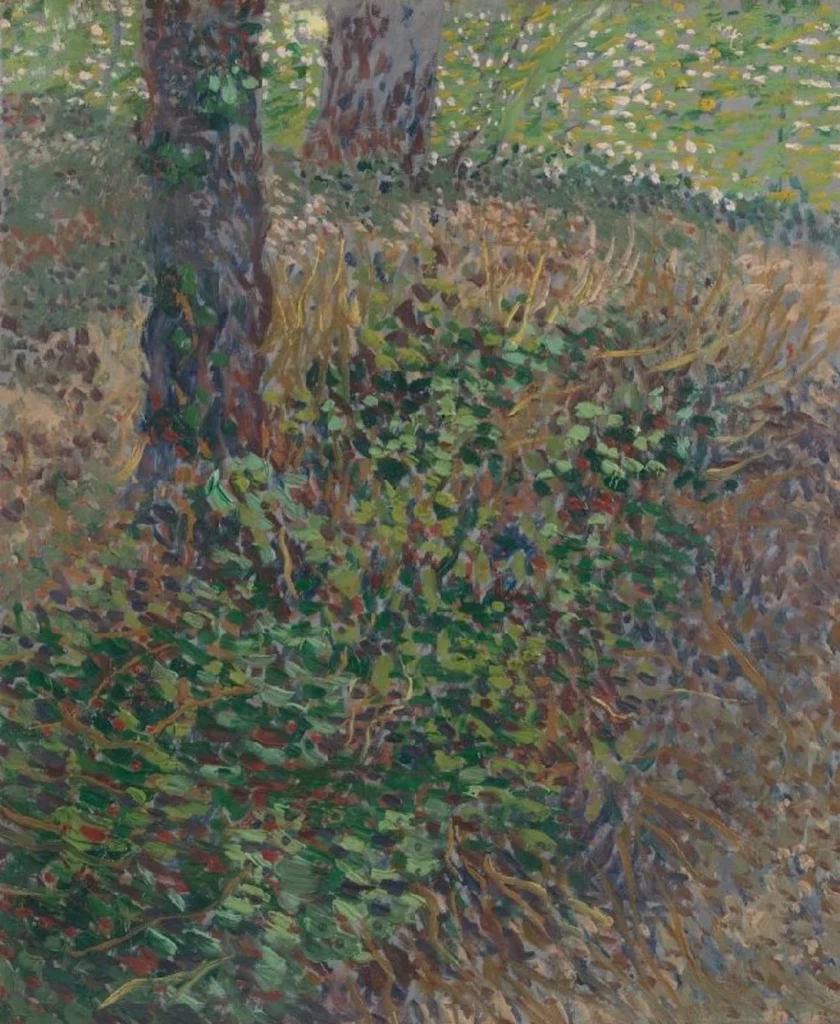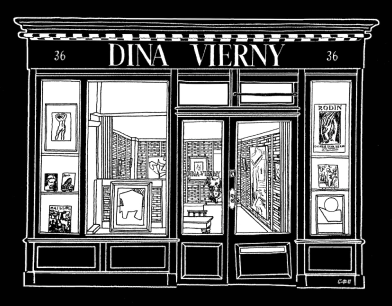All Exhibitions here
The exhibition "Action, Gesture, Paint Women Artist And Global Abstarction, 1940–1970" brings together 85 artists from around the world and presents over 130 works created by women artists between 1940 and 1970, including two canvases by Judit Reigl. The touring exhibition was previously held at London's Whitechapel Gallery and will travel to Kunsthalle Bielefeld in Germany as its final stop.20 july 2023
 Exhibition view "Action, Gesture, Paint Women Artist And Global Abstarction, 1940–1970", Foundation Van Gogh © Grégoire d'Ablon
Exhibition view "Action, Gesture, Paint Women Artist And Global Abstarction, 1940–1970", Foundation Van Gogh © Grégoire d'Ablon The exhibition "Action, Gesture, Paint Women Artist And Global Abstarction, 1940–1970" brings together 85 artists from around the world and presents over 130 works created by women artists between 1940 and 1970, including two canvases by Hungarian artist Judit Reigl. The touring exhibition was previously held at London's Whitechapel Gallery and will travel to Kunsthalle Bielefeld in Germany as its final stop.


Exhibition view "Action, Gesture, Paint Women Artist And Global Abstarction, 1940–1970", Foundation Van Gogh © Grégoire d'Ablon
The aim of the event, which runs until autumn 2023, is to broaden the traditional perception of Abstract Expressionism, an artistic movement mainly associated with American male artists and their freedom of expression and gesture. It also highlights different artistic influences, ranging from surrealism and informal art in Europe and North America, to calligraphic abstraction in North Africa, the Middle East and Asia. The works on display were created in the wake of the Second World War and forced migration. The historical period chosen testifies to the intense upheavals experienced by these artists from over 30 countries: world conflicts, genocides, civil wars and exile. The paintings in this exhibition reflect a collective liberation, led by a growing number of women who are becoming important protagonists in the art world.

Exhibition view "Action, Gesture, Paint Women Artist And Global Abstarction, 1940–1970", Foundation Van Gogh © Grégoire d'Ablon
Judit Reigl was particularly affected by these global conflicts. She managed to flee Hungary after eight unsuccessful attempts in March 1950 and reached Paris at the end of June, most of the journey on foot. The paintings exhibited at the Van Gogh Foundation, "Écriture en masse" (1961) and "Expérience d'apesanteur" (1964), were painted after the artist's arrival in the French capital. Écriture en masse was lent to the Foundation by the Tate Modern in London, while the second work comes from a private collection. The Fondation Vincent van Gogh in Arles also proposes to draw a parallel with the painted work of Vincent van Gogh, considered by many as a post-impressionist and precursor of Fauvism and Expressionism. The only male artist in the exhibition, five of his paintings, grouped together under the title Sols fertiles, highlight his important contribution to the history of gestural and material abstraction.

Vincent van Gogh, "Sous-bois", 1887, Oil on canvas, 46 × 38 cm, Van Gogh Museum (Vincent van Gogh Foundation), Amsterdam
Around the painted works of Judit Reigl and other women artists, the exhibition also presents other major contributions to artistic creation since the middle of the 20th century. It explores the artistic practices that would later develop in the fields of dance and performance. Included are video recordings of performances such as Carolee Schneemann's "Meat Joy" (1964) and Atsuko Tanaka's "Round on Sand" (1968).
The aim of the event, which runs until autumn 2023, is to broaden the traditional perception of Abstract Expressionism, an artistic movement mainly associated with American male artists and their freedom of expression and gesture. It also highlights different artistic influences, ranging from surrealism and informal art in Europe and North America, to calligraphic abstraction in North Africa, the Middle East and Asia. The works on display were created in the wake of the Second World War and forced migration. The historical period chosen testifies to the intense upheavals experienced by these artists from over 30 countries: world conflicts, genocides, civil wars and exile. The paintings in this exhibition reflect a collective liberation, led by a growing number of women who are becoming important protagonists in the art world.
 Exhibition view "Action, Gesture, Paint Women Artist And Global Abstarction, 1940–1970", Foundation Van Gogh © Grégoire d'Ablon
Exhibition view "Action, Gesture, Paint Women Artist And Global Abstarction, 1940–1970", Foundation Van Gogh © Grégoire d'Ablon The exhibition "Action, Gesture, Paint Women Artist And Global Abstarction, 1940–1970" brings together 85 artists from around the world and presents over 130 works created by women artists between 1940 and 1970, including two canvases by Judit Reigl. The touring exhibition was previously held at London's Whitechapel Gallery and will travel to Kunsthalle Bielefeld in Germany as its final stop.
The exhibition "Action, Gesture, Paint Women Artist And Global Abstarction, 1940–1970" brings together 85 artists from around the world and presents over 130 works created by women artists between 1940 and 1970, including two canvases by Hungarian artist Judit Reigl. The touring exhibition was previously held at London's Whitechapel Gallery and will travel to Kunsthalle Bielefeld in Germany as its final stop.
The aim of the event, which runs until autumn 2023, is to broaden the traditional perception of Abstract Expressionism, an artistic movement mainly associated with American male artists and their freedom of expression and gesture. It also highlights different artistic influences, ranging from surrealism and informal art in Europe and North America, to calligraphic abstraction in North Africa, the Middle East and Asia. The works on display were created in the wake of the Second World War and forced migration. The historical period chosen testifies to the intense upheavals experienced by these artists from over 30 countries: world conflicts, genocides, civil wars and exile. The paintings in this exhibition reflect a collective liberation, led by a growing number of women who are becoming important protagonists in the art world.

Exhibition view "Action, Gesture, Paint Women Artist And Global Abstarction, 1940–1970", Foundation Van Gogh © Grégoire d'Ablon
Judit Reigl was particularly affected by these global conflicts. She managed to flee Hungary after eight unsuccessful attempts in March 1950 and reached Paris at the end of June, most of the journey on foot. The paintings exhibited at the Van Gogh Foundation, "Écriture en masse" (1961) and "Expérience d'apesanteur" (1964), were painted after the artist's arrival in the French capital. Écriture en masse was lent to the Foundation by the Tate Modern in London, while the second work comes from a private collection. The Fondation Vincent van Gogh in Arles also proposes to draw a parallel with the painted work of Vincent van Gogh, considered by many as a post-impressionist and precursor of Fauvism and Expressionism. The only male artist in the exhibition, five of his paintings, grouped together under the title Sols fertiles, highlight his important contribution to the history of gestural and material abstraction.

Vincent van Gogh, "Sous-bois", 1887, Oil on canvas, 46 × 38 cm, Van Gogh Museum (Vincent van Gogh Foundation), Amsterdam
Around the painted works of Judit Reigl and other women artists, the exhibition also presents other major contributions to artistic creation since the middle of the 20th century. It explores the artistic practices that would later develop in the fields of dance and performance. Included are video recordings of performances such as Carolee Schneemann's "Meat Joy" (1964) and Atsuko Tanaka's "Round on Sand" (1968).
